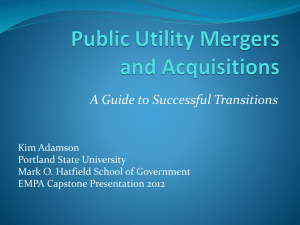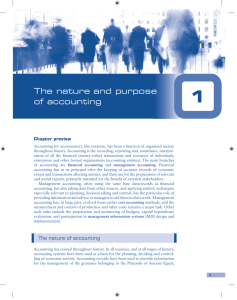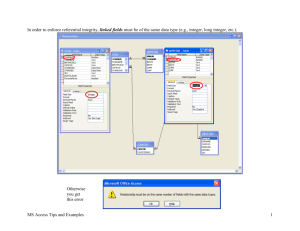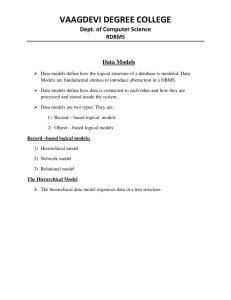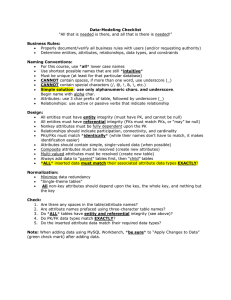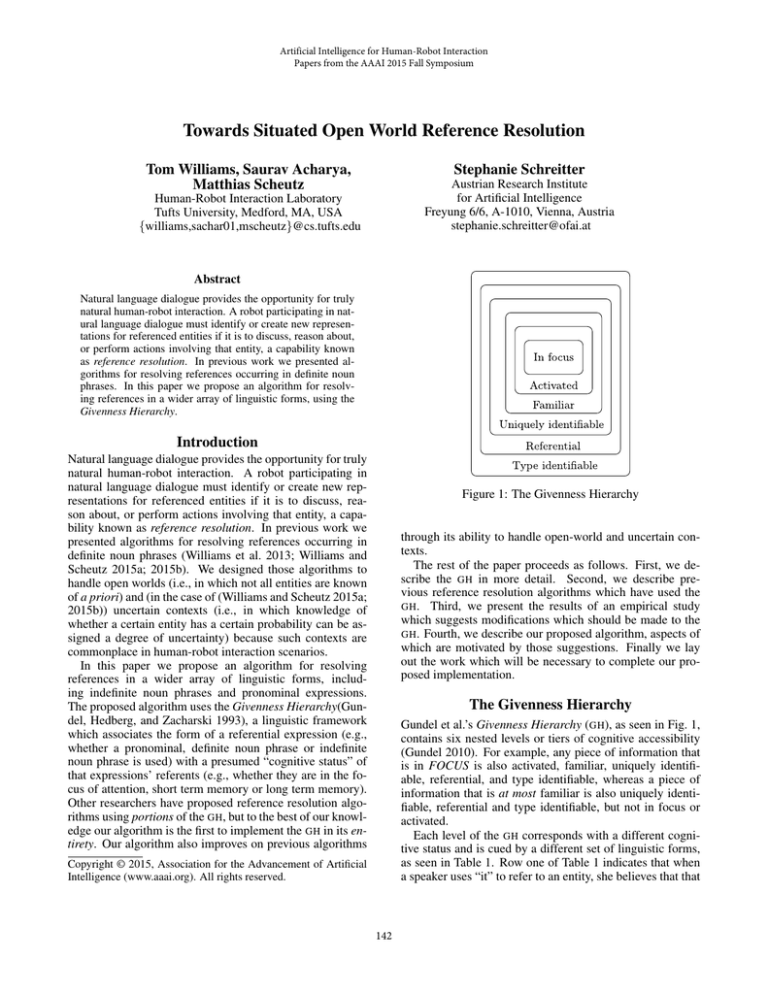
Artificial Intelligence for Human-Robot Interaction
Papers from the AAAI 2015 Fall Symposium
Towards Situated Open World Reference Resolution
Stephanie Schreitter
Tom Williams, Saurav Acharya,
Matthias Scheutz
Austrian Research Institute
for Artificial Intelligence
Freyung 6/6, A-1010, Vienna, Austria
stephanie.schreitter@ofai.at
Human-Robot Interaction Laboratory
Tufts University, Medford, MA, USA
{williams,sachar01,mscheutz}@cs.tufts.edu
Abstract
Natural language dialogue provides the opportunity for truly
natural human-robot interaction. A robot participating in natural language dialogue must identify or create new representations for referenced entities if it is to discuss, reason about,
or perform actions involving that entity, a capability known
as reference resolution. In previous work we presented algorithms for resolving references occurring in definite noun
phrases. In this paper we propose an algorithm for resolving references in a wider array of linguistic forms, using the
Givenness Hierarchy.
Introduction
Natural language dialogue provides the opportunity for truly
natural human-robot interaction. A robot participating in
natural language dialogue must identify or create new representations for referenced entities if it is to discuss, reason about, or perform actions involving that entity, a capability known as reference resolution. In previous work we
presented algorithms for resolving references occurring in
definite noun phrases (Williams et al. 2013; Williams and
Scheutz 2015a; 2015b). We designed those algorithms to
handle open worlds (i.e., in which not all entities are known
of a priori) and (in the case of (Williams and Scheutz 2015a;
2015b)) uncertain contexts (i.e., in which knowledge of
whether a certain entity has a certain probability can be assigned a degree of uncertainty) because such contexts are
commonplace in human-robot interaction scenarios.
In this paper we propose an algorithm for resolving
references in a wider array of linguistic forms, including indefinite noun phrases and pronominal expressions.
The proposed algorithm uses the Givenness Hierarchy(Gundel, Hedberg, and Zacharski 1993), a linguistic framework
which associates the form of a referential expression (e.g.,
whether a pronominal, definite noun phrase or indefinite
noun phrase is used) with a presumed “cognitive status” of
that expressions’ referents (e.g., whether they are in the focus of attention, short term memory or long term memory).
Other researchers have proposed reference resolution algorithms using portions of the GH, but to the best of our knowledge our algorithm is the first to implement the GH in its entirety. Our algorithm also improves on previous algorithms
Figure 1: The Givenness Hierarchy
through its ability to handle open-world and uncertain contexts.
The rest of the paper proceeds as follows. First, we describe the GH in more detail. Second, we describe previous reference resolution algorithms which have used the
GH . Third, we present the results of an empirical study
which suggests modifications which should be made to the
GH . Fourth, we describe our proposed algorithm, aspects of
which are motivated by those suggestions. Finally we lay
out the work which will be necessary to complete our proposed implementation.
The Givenness Hierarchy
Gundel et al.’s Givenness Hierarchy (GH), as seen in Fig. 1,
contains six nested levels or tiers of cognitive accessibility
(Gundel 2010). For example, any piece of information that
is in FOCUS is also activated, familiar, uniquely identifiable, referential, and type identifiable, whereas a piece of
information that is at most familiar is also uniquely identifiable, referential and type identifiable, but not in focus or
activated.
Each level of the GH corresponds with a different cognitive status and is cued by a different set of linguistic forms,
as seen in Table 1. Row one of Table 1 indicates that when
a speaker uses “it” to refer to an entity, she believes that that
Copyright © 2015, Association for the Advancement of Artificial
Intelligence (www.aaai.org). All rights reserved.
142
Level
In focus
Activated
Familiar
Uniquely id-able
Referential
Type id-able
Cognitive Status
in focus of attention
in working memory
in LTM
in LTM or new
new
new or hypothetical
Form
it
this,that,this N
that N
the N
indef. this N
aN
Table 1: Cognitive Status and Form in the Givenness Hierarchy
Figure 2: Kehler’s Modified Hierarchy
entity is in her interlocutor’s focus of attention. Row three
indicates that when a speaker uses “that N” to refer to an entity, she believes that that entity is in her interlocutor’s long
term memory (and may or may not also be in her interlocutor’s working memory or focus of attention).
Gundel et al.’s “coding protocol” suggests the cognitive
status to associate with different pieces of information (Gundel et al. 2006). For example, the coding protocol suggests
that the syntactic topic of the immediately preceding sentence should be in focus, speech acts and targets of gestures
or sustained eye gaze should be activated, and any entity
mentioned previously in the current dialogue should be familiar.
Taken together, the GH and its coding protocol represent
a powerful framework for reference resolution, as they provide (1) data structures needed for reference resolution, (2)
guidelines regarding population of those data structures, and
(3) guidelines regarding retrieval from those data structures.
Furthermore, Gundel et al. have provided strong experimental justification for their framework (e.g., (Gundel et al.
2010)).
Several previous research efforts in Human-Robot or
Human-Agent interaction have made use of the GH, as
its guidelines for simultaneously dealing with information coming from one’s environmental, dialogue, and preexisting knowledge make it especially valuable for situated
contexts. However, while several such efforts have made
tangential use of the GH (e.g., Byron et al.’s use of the Givenness Hierarchy’s six levels as possible outputs of a learned
decision tree for referential expression generation), we are
only aware of two previous attempts to make full use of the
GH . In the next section we describe those two implementations.
Figure 3: Chai’s Modified Hierarchy
2. Otherwise, if the currently selected object meets all semantic type constraints imposed by the referring expression (i.e., the museum requires a museum referent; bare
forms such as it and that are compatible with any object),
choose that object.
3. Otherwise, if there is a visible object that is semantically
compatible, then choose that object (this happened three
times; in each case there was only one suitable object).
4. Otherwise, a full NP (such as a proper name) was used
that uniquely identified the referent.
The second implementation of the GH we will examine
is the implementation presented in (Chai, Prasov, and Qu
2006). Chai et al. identify two principle problems with
this implementation (Chai, Prasov, and Qu 2006). First, it
is impossible to identify or resolve ambiguities using the
four rules above. For example, if one cannot unambiguously determine which of several objects a gesture was targeting, problems may arise when considering rule one. If
one cannot unambiguously determine which of several objects an underspecified referential expression was targeting,
problems may arise when considering rule three. Second,
Kehler et al.’s implementation is unable to handle utterances
containing multiple referential expressions or gestures.
To address these concerns, Chai et al. created their own
implementation of the GH (Chai, Prasov, and Qu 2006), in
which they combined a subset of the GH with Grice’s theory
of Conversational Implicature (Grice 1970)to produce the
modified hierarchy seen in Fig. 3.
Chai et al. use Grice’s theory of Conversational Implicature (Grice 1970) to argue that gestures must have the highest cognitive status, since a gesture intentionally singles out
Previous Implementations
The first implementation of the GH that we will examine
is the implementation presented in (Kehler 2000). In that
work, Kehler et al. present the modified hierarchy seen in
Fig. 2. As seen in Fig. 2,Kehler et al. omit the referential
and type identifiable levels of the GH. They omit these tiers
because they are primarily interested in pen-and-tablet interfaces, and when using such an interface it is unlikely for
one to refer to unknown or hypothetical entities. Kehler et
al. used their modified hierarchy to craft four simple rules
which they found capable of resolving all the references they
encountered (presented here verbatim):
1. If the object is gestured to, choose that object
143
it always knows with complete certainty whether or not an
entity has a certain property. In reality, an agent may only
be able to say that an entity has a certain property with some
probability or with some degree of confidence. Furthermore,
an agent may be cognizant of the fact that it simply does not
know whether an entity has a certain property.
Second, consider the following command, of a form not
unreasonable to expect in many human-robot interaction
scenarios:
an entity or group of entities. The second tier in their hierarchy is “Focus”, which subsumes Gundel’s in focus and
activated tiers. The third tier in their hierarchy is “Visible”, which subsumes Gundel’s familiar and uniquely identifiable tiers. Finally, the lowest level of their hierarchy is
the “Others” tier, which subsumes Gundel’s referential and
type identifiable tiers. This final tier does not appear to be
used by Chai et al. or to be accessible using their algorithm.
Like Kehler et al., Chai et al. are primarily interested in reference resolution in the context of an interface in which it is
unlikely for one to refer to unknown or hypothetical entities.
In particular, Chai et al. investigate reference resolution in
the context of a graphical interface with which participants
interact through speech, pointing, and circling.
Chai et al. present a greedy reference resolution algorithm
which makes use of their modified hierarchy. This algorithm
first assigns a score between each referential expression in a
given utterance and each entity contained in three vectors:
(1) A vector associated with the first tier of their modified
hierarchy, containing all entities that have been gestured towards during the utterance, (2) a vector associated with the
second tier of their modified hierarchy, containing all other
entities thought to be in focus, and (3) a vector associated
with the third tier of their modified hierarchy, containing all
other visible entities. The score assigned to each entity contained in one of these vectors is calculated by multiplying
(1) the probability of the entity being selected from it’s vector, (2) the probability of that tier being selected given the
linguistic form of the examined referential expression, and
(3) the “compatibility” between the examined referential expression and the examined entity. This compatibility is said
to be 1 if the target entity has all the properties mentioned in
the referential expression, is of the same type as that mentioned in the referential expression (if any), has the same
name as that mentioned in the referential expression (if any),
and was gestured towards at the same time as the referential
expression was uttered (if any gestures occurred). If any of
these conditions do not obtain, the compatibility is said to be
0. This compatibility is thus binary in nature and does not
account for uncertainty.
Once the algorithm has scored all visible entities, it marks
the referential expression most likely to have been used to
describe each entity. The algorithm then proceeds top-tobottom through the hierarchy of vectors (i.e., from “Gesture” to “Visible”), greedily assigning the best match. For
example, consider Example 1.
(1)
(2)
Get my laptop from my office, and if you see a
charger bring that too.
This sentence contains three referential expressions (i.e., the
three bolded noun phrases). None of these three expressions
could be properly handled using Chai’s algorithm and modified hierarchy.
1. my laptop cannot be resolved because its referent is (presumably) not currently visible.
2. my office cannot be resolved because its referent is (presumably) not currently visible. What is more, my office is
not an object, per se, and it is unclear whether Chai’s modified hierarchy would be equipped to handle such entities,
which cannot be gestured at in the same way as objects or
icons.
3. a charger cannot be resolved because its referent is (presumably) not currently visible. What is more, it is not
even known to exist, as it is hypothetical in nature. In order to resolve referents to such entities, it is necessary to
model one’s environment as an open world in which new
entities may be added through experience or through dialogue. Chai’s algorithm and modified hierarchy are not
equipped to handle either type of new entity.
Third, a robot may need to resolve references to events,
speech acts, or other entities that cannot physically exist, as
seen in Examples 4a and 4b.
(3)
(4)
I’m sorry, but I failed to complete the task.
a. Can you repeat it?
b. Can you repeat that?
Fourth, because Chai’s modified hierarchy combines the first
two levels of the GH, their algorithm would not be able to
properly distinguish between Examples 4a and 4b even if it
were able to handle references to physically nonexistent entities. When Example 4a is used to respond to Example 3,
“it” unambiguously refers to “the task”. However, this is not
the case when Example 4b is used. The GH predicts that
when a referential form associated with the activated level
is used, one should prefer an activated referent (such as a
speech act) to an in focus referent (such as the focus of the
previous sentence), because if the speaker had meant to refer
to an in-focus entity she could have used an in-focus cueing
linguistic form. Thus, while Example 4b could refer to either the speech act or the failed task, the speech act should
be preferred. Gundel et al. have empirically verified that
these two hierarchical levels are distinguished between in a
wide variety of languages beyond English, including Eegimaa, Kumyk, Ojibwe, and Tunisian Arabic (each of which
Compare it with this house and this one.
When this utterance is heard, the algorithm first scores each
of the three bolded referential expressions against each visible entity, and marks for each entity which of the three expressions is most likely to refer to it. The algorithm then
assigns to each referential expression the highest scored entity, if any, associated with it in the “Gesture” vector. If any
expressions are left unassigned, the process is repeated with
the “Focus” vector, and then with the “Visible” vector.
We believe that this algorithm and modified hierarchy are
insufficient for realistic human-robot interaction scenarios.
First, the algorithm presented by Chai et al. assumes that
144
and 11.36% of task-relevant referring expressions in T2 can
be resolved. When accounting for gesture and eye gaze,
75.22% of such expressions can be resolved in T1, and 50%
can be resolved in T2.
The use of eye gaze in particular was striking: In both T1
and T2, participants frequently uttered underspecified definite noun phrases to refer to the object they were currently
looking at. This is consistent with the GH coding protocol,
which suggests that entities that are the subject of speechsimultaneous gesture or gaze should be considered to have
the cognitive status ACTIVATED. However, it may not always be possible to identify the unique entity at which an
interlocutor is looking. We thus suggest that all entities in
an interlocutor’s field of view be considered ACTIVATED.
As ACTIVATED is roughly equivalent to short term memory (STM), this represents the possibility of any entity in the
vicinity of an interlocutor’s gaze being in her STM. (Gundel 2010) suggests that there may be differing degrees of
being in focus. We suggest this consideration be extended
to ACTIVATED entities. Thus, while all entities in an interlocutor’s field of view may be considered ACTIVATED,
those recently or sustainedly looked at would have higher
activation scores.
In T2, some instructors used the underspecified referring
expression “the tube” to refer to one of the two visible tubes.
However, such references were easily resolved by interlocutors because the expressions were uttered while gazing or
pointing at one of the two tubes. Instead of specifically
checking what is the target of one’s gaze or gesture when
resolving a reference (as performed by Chai), one could resolve such a reference by increasing the activation score of
the target tube when it is gazed or pointed at. If entities of
a particular cognitive status are considered in decreasing order of activation level, then the tube that is the target of gaze
or gesture will naturally be arrived at first, allowing it to be
identified without the use of explicit gaze or gesture checking during the resolution process.
In T1, instructors often used underspecified noun phrases
such as Objekt (object), Gerät (device), or Ding (thing) to refer to the uniquely identifiable board. These underspecified
noun phrases would also be resolveable using the suggested
approach.
In both T1 and T2, linguistic forms cueing entities in FOCUS could often not be resolved using automatic anaphora
resolution due to the linguistic distance between the form
used and the last reference to the entity. Just as gesture and
eye gaze may be used to increase the activation level of entities considered ACTIVATED, we suggest these measures
also be used to increase the focus level of entities considered to be in FOCUS. This contrasts with the approaches
presented by Gundel et al. and Chai et al., neither of which
use visual cues when considering entities in the FOCUS tier.
is genetically and typologically unrelated to the other three)
(Gundel et al. 2010).
Fifth, in natural human-robot dialogues it is not unreasonable to expect complex noun phrases such as:
(5)
Do you see the red block on that blue block?
Because Chai et al.’s algorithm uses a greedy approach (instead of, e.g., the graph matching approach they used in previous work), it may choose an incorrect referent for the first
considered referential expression, and may thus be unable
to successfully resolve subsequent referential expressions.
Chai et al. argue that using a greedy approach is advantageous because it allows significant pruning of the search
space. However, their algorithm scores all entities against
all referential expressions before employing its greedy approach. In a realistic Human-Robot Interaction scenario,
this may not be practical, as a robot may know of hundreds
or thousands of entities. Furthermore, the process of checking whether certain properties hold for all entities may be
cost prohibitive. For example, while determining whether
a given person is a man or not may be accomplished by
a simple database lookup, determining whether two rooms
are across from each other may require more expensive
computation. An algorithm which performed such assessments lazily (i.e., only when needed) as the search space
was pruned would potentially be much more efficient.
We argue that the shortcomings of previous GH implementations are sufficient to warrant a new implementation.
In the following section, we present the results of an empirical study which suggest modifications to the GH itself which
should be incorporated into such an implementation.
Experimental Results
In (Schreitter and Krenn 2014), Schreitter et al. examine how humans refer to objects in natural human-human
and human-robot task descriptions. In that experiment, performed at the Technical University Munich, subjects participated in human-human or human-robot dyads consisting of
a human instructor who was asked to explain four tasks in
German to a human or robot listener. In this section, we analyze the results collected by Schreitter et al. in the humanhuman dyads of two of the four tasks. In the first task (T1),
the instructor and listener worked together to carry a board
around a table and place it in a particular location (22 dyads).
In the second task (T2), the instructor explained and demonstrated to the listener how to connect two sections of tubing
and affix the tubing to a box (16 dyads). We examine these
two tasks in particular due to the significant difference in
types of objects and references they include. We examine
the human-human dyads in particular as this is the type of
communication toward which human-robot communication
strives.
Information Retrieval
Gaze and Gesture Handling
As described previously, a drawback of Chai et al.’s approach is its strictly top-down search through the tiers of
the GH. However, while the tiered nature of the GH suggests a bottom-up approach, this is not always appropriate.
In T1, participants often referred to the board simply as “the
The results of this experiment emphasize the importance
of developing a genuinely multi-modal approach to reference resolution: Without accounting for gesture or eye gaze,
only 21.24% of task-relevant referring expressions in T1
145
Level
FOCUS
ACTIVATED
FAMILIAR
DEFINITE
Search Plan
FOC
ACT → FOC
ACT → FOC → FAM
ACT → FOC → LTM
Level
FOCUS
Table 2: Search Plans for GH tiers 1-4
Level
FOCUS
ACTIVATED
FAMILIAR
DEFINITE
THIS-N-ACTIVATED
INDEFINITE
ACTIVATED
Search Plan
FOC
ACT → FOC
ACT → FOC → FAM
ACT → FOC → LTM
ACT → FOC → HYP
HYP
FAMILIAR
LTM
Contents
Main clause subject of clause n-1
Syntactic Focus of clause n-1
* Event denoted by clause n-1
* Entities visible in int.’s region of attention
* Focus of int.’s gesture, if any
* Focus of int.’s sustained eye gaze, if any
* Speech act associated with clause n-1
* All propositions entailed by clause n-1
All entities referenced in clause n-1
* The robot’s current location
All declarative memory
Table 4: Contents of Relevant Data Structures
Table 3: Search Plans for Complete GH
tures are used to resolve references in parsed utterances.
All capabilities described in these sections are performed
by components of the Distributed, Integrated, Affect, Reflection and Cognition (DIARC) architecture (Scheutz et al.
2007), as implemented in the Agent Development Environment (ADE) (Scheutz 2006; Scheutz et al. 2013).
board”. According to the GH, a definite noun phrase of this
form cues the UNIQUELY IDENTIFIABLE tier. However,
starting at this tier and then proceeding up the hierarchy
would suggest that the board in the task setting is a less appropriate choice than any other board the listener may have
previously encountered. This problem manifests itself at the
FAMILIAR level of the hierarchy as well. As such, we suggest that referential forms cueing the UNIQUELY IDENTIFIABLE and FAMILIAR tiers be processed in the same way
as referential forms cueing the ACTIVATED tier, considering the tier they cue only after considering the ACTIVATED
and FOCUS tiers. This is in line with (Gundel, Hedberg,
and Zacharski 2012), in which Gundel et al. argue that for
definite noun phrases, referents in one’s current perceptual
environment are preferred to those found by searching Long
Term Memory (LTM). This suggestion yields Table 2, which
lists search plans for forms cueing the first four levels of the
GH .
Unfortunately, Table 2 does not differentiate between using this N to cue the ACTIVATED tier and to cue the REFERENTIAL tier. While it may be possible to use factors such
as tense to tell when one is using the REFERENTIAL-cueing
sense, we believe that a first step towards appropriately handling the REFERENTIAL-cueing sense would be to treat all
uses of this N as ACTIVATED-cueing so long as a suitable
referent can be found at the ACTIVATED or FOCUS tiers,
and otherwise treating such a use as REFERENTIAL cueing.
A first step might also use a single process to handle REFERENTIAL and TYPE-IDENTIFIABLE cues, as both lead to
the construction of new representations. These suggestions
yield Table 3.
Parsing
Trees representing the syntactic structure of incoming utterances are generated using a CCG parser with a dependency
grammar. The structure of this tree is then analyzed to produce (1) a set of logical formulae representing the surface
semantics of the utterance, (2) a set of “status cue” mappings for each referenced entity, and (3) the type of utterance
which was heard. For example, the utterance “The commander needs a medkit” would be parsed into the following tree:
root
dec
needs
subj
dir-obj
medkit
commander
det
det
a
the
From this tree, we then extract:
1. The set of formulae
{needs(X, Y ) ∧ commander(X) ∧ medkit(Y )}.
2. The set of status cue mappings
{X → DEFINITE, Y → INDEFINITE}.
3. The utterance type “STATEMENT” (indicated by the label “dec” on the arc pointing to the root node).
Data Structure Population
Our Approach
Our approach uses four data structures: FOC, ACT, FAM,
and LTM, corresponding with the first four levels of the GH
(levels five and six do not have associated structures, as they
involve construction of new representations). In this section,
we describe how these four data structures are populated, as
summarized in Table 4. Lines marked with a star are not
implemented, and represent future work.
For clause n of some natural language utterance, we first
update FOC, ACT and FAM using (primarily) the guidelines
In this section, we propose an algorithm for resolving referential expressions associated with all six levels of the
GH . This approach combines the suggestions proposed in
the previous section with our previous reference resolution
work ((Williams and Scheutz 2015a; 2015b)). We will first
discuss how utterances are parsed and analyzed. We will
then describe the data structures we use and how they are
updated. Finally, we will describe how those data struc-
146
Algorithm 1 GH-RESOLVE(S, GH, P OW ER)
specified in Gundel et al.’s GH coding protocol (Gundel et
al. 2006). Linguistically, this entails placing the main clause
subject, syntactic focus, and event denoted by clause n-1
into FOC (each of which may be extracted from the syntactic representation of clause n-1), placing the speech act
and any propositions entailed by clause n-1 into ACT, and
placing all entities referenced at all in clause n-1 into FAM.
In addition, each location visited by the robot and its interlocutor should be placed into FAM, and any entities within
the interlocutor’s region of attention should be placed into
ACT. The linguistic contents of FOC and ACT are reset after each clause, and FAM is reset after each dialogue. LTM
is never reset. Once these structures are updated, we resolve
all references contained in clause n.
1:
S: set of formulae, M : set of status cue mappings, GH: FOC, ACT, and FAM
data structures, P OW ER: a Probabilistic, Open-World Entity Resolver
2: V = [v|v ∈ S.vars] sorted by M (v)
3: Θ = create plan table(M )
4: H = ∅
5: for all P ∈ Θ do
6:
Pd = [p|p ∈ P, p.tier = LT M ]
7:
Vp = new list
8:
for all p ∈ (P \ Pd ) do
9:
Vp = p.var ∪ Vp
10:
H = ASSESS(S, Vp , H, p.var, p.tier, P OW ER)
11:
end for
12:
for all h ∈ H do
13:
h = P OW ER.resolve(bind(S, h), order(Pd .vars)))
14:
end for
15:
H = [h|h ∈ H, h.prob >= τresolve ]
16:
if | H |> 0 then
17:
BREAK
18:
end if
19: end for
20: if | H |6= 1 then
21:
return H // AMBIGUOUS or UNRESOLVEABLE
22: else
23:
return P OW ER.assert(bind(S, H[0]))
24: end if
Anaphora and Reference Resolution
To resolve the references in a given clause, that clause is
first viewed as a graph whose vertices and edges are the respective variables and formulae seen in the semantics of that
clause1 . This graph is then partitioned into connected components. For each partition, GH-RESOLVE is used to resolve all references found in that partition, producing a set
of variable-entity bindings.
Alg. 1 (GH-RESOLVE) takes three parameters: (1) S
(the semantics of clause n), (2) M (the set of status cue
mappings for clause n), (3) GH (containing the F OC,
ACT , and F AM data structures), and (4) POWER (a module which performs Probabilistic, Open-World Entity Resolution to interface with LTM, as described in (Williams
and Scheutz 2015b)). GH-RESOLVE first collects the variables appearing in S and sorts them with respect to the tier
they are cued towards. For example, X → F OCU S and
Y → F AM ILIAR appear in M , then X will appear before Y (Alg. 1 line 2).
Before GH-RESOLVE begins trying different variableentity assignments, it must determine which data structures
to examine when looking for those entities. This is determined by using the plan associated with each level of the
hierarchy, as seen in Table 3. This table dictates that if M
contains X→ FOCUS then X must be looked for in the FOCUS data structure, whereas if M contains X→ ACTIVATED
then X must be looked for in the activated structure, and if
no satisfactory match is found there, it must be looked for in
the F OCU S data structure.
(6)
Y
ACT
ACT
ACT
FOC
FOC
FOC
IND
IND
IND
X
ACT
FOC
LTM
ACT
FOC
LTM
ACT
FOC
LTM
Table 5: Sample Strategy Table
through Θ one row at a time until a solution is found or the
end of the table is reached. For each table entry P , GHRESOLVE first separates the variables for which it must
query LTM from all other variables (line 6). It then intitializes an empty list Vp to hold variables that have been examined thus far for entry P (line 7). Next, it iterates over
each (variable, tier) pair in that table row, as we will now
describe.
Consider the first row of Table 5. GH-RESOLVE would
first examine the first entry in this row, which says to look for
Y ’s referent in the ACT data structure. The search through
the appropriate data structure is effected through the call to
ASSESS on line 10. When ASSESS is called with p.tier
equal to HYP (an instruction to hypothesize a new entity),
it creates a new binding between p.var and “?”. Otherwise,
it adds p.var to Vp , and POWER to find the maximum likelihood assignment from variables in Vp to known entities.
For example, if Example 6 is heard and there is one entity
in ACT (e.g., obj 13), ASSESS would consult POWER to
see to what degree obj 13 could be considered to be a boat,
The box on this red boat
To handle multi-variable expressions, GH-RESOLVE creates a table Θ, storing all multivariable plan combinations.
For example, if the referential expression seen in Example
6 is parsed as: {box(X) ∧ boat(Y) ∧ red(Y) ∧ on(X,Y)} with
status cue mappings {X→ DEFINITE, Y→ THIS-N-ACT},
Table 5 of exploration strategies will be created.
After this table is created (line 3), an empty set of candidate hypotheses H is created. GH-RESOLVE then goes
1
To properly handle declerative and imperative utterances, we
omit the formula associated with the main clause verb from consideration. As later discussed, future work will include using
common-sense reasoning to account for this formula.
147
Conclusions and Future Work
and to what degree it could be considered to be red, and
then create a hypothesis mapping Y to obj 13 with probability equal to the product of the two probabilities returned by
POWER. Once all formulae containing only variable p.var
are examined, all those containing both p.var and any other
previously examined variables are examined. For Example 6, this would involve inquiring to what degree the candidate entities for X could be considered to be “on” each
candidate entity for Y . After each variable is considered,
all candidate bindings whose likelihoods fall below a certain
threshold are removed.
For example, if resolving Y produces hypothesis list
{((Y → obj 13) → 0.8), ((Y → obj 12) → 0.75)},
and resolving X produces the hypothesis list
{((X → obj 5) → 0.9)},
these are combined into:
{((Y → obj 13, X → obj 5) → 0.72),
((Y → obj 12, X → obj 5) → 0.675)}.
If ASSESS determines that on(X, Y ) has probability 0.2 for
the first of these hypotheses and 0.9 for the second, the two
hypotheses are updated to
{((Y → obj 13, X → obj 5) → 0.144),
((Y → obj 12, X → obj 5) → 0.6075)}.
If τ assess is set to 0.6, for example, then the first of these
hypotheses would be removed.
GH-RESOLVE now considers all variables which were
previously set aside because they were to be searched for in
LTM. If any such variables exist, GH-RESOLVE considers
each candidate binding in H. For each, S is bound using
h’s variable bindings, and an ordering of the variables Vh
to be queried in LTM is created (e.g, based on the prepositional attachment observed in S). These bound semantics
and variable ordering are then used by POWER to determine
(1) whether any of the variables in Vh refer to unknown entities, and (2) which entities in LTM are the most probable referents for each other variable in Vh (line 13). The POWER
resolution algorithm is beyond the scope of this paper, but
is described in (Williams and Scheutz 2015b). The set of
hypotheses H is then updated using these results.
Finally, once a solution is found or all table rows are
exhausted, the number of remaining hypotheses is examined. If more or less than one hypothesis was found, GHRESOLVE returns the set of solutions. This signifies that
the referential expression was either ambiguous or unresolveable. If only one hypothesis remains, however, GHRESOLVE uses the variable bindings of that hypothesis to
update the set of semantics S, and then uses POWER to
assert new representation for each variable bound to “?”
(line 24). For example, if the results of Example 6 are
a single hypothesis with probability 0.7 in which X is
bound to obj 4 and Y is bound to “?”, POWER will create a new object (perhaps with identifier 5) with properties
{boat(obj 5), red(obj 5), on(obj 4, obj 5)} and {((Y →
obj5 , X → obj4 ) → 0.7)} will be returned. Once all partitions have been processed in this way, the resulting sets of
bindings are combined into a comprehensive set of candidate
binding hypotheses.
We have proposed an open world reference resolution algorithm which uses the Givenness Hierarchy to handle definite noun phrases, indefinite noun phrases, and pronominal
expressions. This allows our algorithm to handle a wider
range of linguistic expressions than previous approaches.
And, unlike previous approaches, our algorithm is able to
handle open world and uncertain contexts. We thus argue
that it is better suited for human-robot interaction scenarios than are previous GH-enabled reference resolution algorithms. We have not yet evaluated the proposed algorithm
on a robot as some components still remain to be adapted
for use on robots. And, as seen in Table 4, the F OC, ACT ,
and F AM data structures are thus far only populated with
directly referenced entities; future work will involve populating them with those entities observed visually or inferred
from incoming utterances. Future work may also investigate
better ways to determine whether a referential expression is
cueing the FAMILIAR and REFERENTIAL levels.
We must also determine the best way to calculate activation and focus scores. While there have been many previous approaches towards measuring the salience of observed
entities, we will need to develop a scoring system which is
able to balance visual salience with a variety of other factors,
such as duration of gaze and recency of mention in dialogue.
Future work will also include integration of commonsense reasoning capabilities: We do not currently consider
the verb used in an utterance when resolving the references
contained in that utterance. Common-sense reasoning may
allow the robot to determine that some referents are less
likely given, e.g., the action it is being asked to perform on
that referent.
Finally, we must better integrate the proposed algorith
with the rest of our robotic architecture. Currently, the most
probable resolution hypothesis is bound to the set of semantics S, which is then sent to DIARC’s pragmatic analysis
component (Williams et al. 2015). However, if the set of resolution hypotheses produced by GH-RESOLVE has more or
less than one member, it would be prudent to ask for clarification: If the set of hypotheses H is empty, the robot must
alert its interlocutor that it doesn’t know what entities he or
she was refering to; If H has more than one member, the
robot should ask its interlocutor which of those hypotheses
is correct. After completing the implementation of our algorithm, this will be the immediate focus of our work.
Acknowledgments
This work was in part funded by grant N00014-14-1-0149
from the US Office of Naval Research.
References
Chai, J. Y.; Prasov, Z.; and Qu, S. 2006. Cognitive principles
in Robust multimodal interpretation. Journal of Artificial
Intelligence Research 27:55–83.
Grice, H. P. 1970. Logic and conversation. In et al., C., ed.,
Syntax and Semantics 3: Speech Acts. Elsevier.
148
Gundel, J. K.; Hedberg, N.; Zacharski, R.; Mulkern, A.;
Custis, T.; Swierzbin, B.; Khalfoui, A.; Humnick, L.; Gordon, B.; Bassene, M.; and Watters, S. 2006. Coding protocol for statuses on the givennes hierarchy. unpublished
manuscript.
Gundel, J. K.; Bassene, M.; Gordon, B.; Humnick, L.; and
Khalfaoui, A. 2010. Testing predictions of the Givenness
Hierarchy framework: A crosslinguistic investigation. Journal of Pragmatics 42(7):1770–1785.
Gundel, J. K.; Hedberg, N.; and Zacharski, R. 1993. Cognitive status and the form of referring expressions in discourse.
language 274–307.
Gundel, J. K.; Hedberg, N.; and Zacharski, R. 2012. Underspecification of cognitive status in reference production:
Some empirical predictions. Topics in cognitive science
4(2):249–268.
Gundel, J. 2010. Reference and Accessibility from a Givenness Hierarchy Perspective. International Review of Pragmatics 2(2):148–168.
Kehler, A. 2000. Cognitive Status and Form of Reference in
Multimodal Human-Computer Interaction. In Proceedings
of the 14th AAAI Conference on Artificial Intelligence.
Scheutz, M.; Schermerhorn, P.; Kramer, J.; and Anderson,
D. 2007. First steps toward natural human-like HRI. Autonomous Robots 22(4):411–423.
Scheutz, M.; Briggs, G.; Cantrell, R.; Krause, E.; Williams,
T.; and Veale, R. 2013. Novel mechanisms for natural
human-robot interactions in the diarc architecture. In Proceedings of AAAI Workshop on Intelligent Robotic Systems.
Scheutz, M. 2006. ADE - steps towards a distributed development and runtime environment for complex robotic agent
architectures. Applied Artificial Intelligence 20(4-5):275–
304.
Schreitter, S., and Krenn, B. 2014. Exploring inter-and intraspeaker variability in multi-modal task descriptions. In The
23rd IEEE International Symposium on Robot and Human
Interactive Communication (RO-MAN), 43–48. IEEE.
Williams, T., and Scheutz, M. 2015a. A domainindependent model of open-world reference resolution. In
Proceedings of the 37th annual meeting of the Cognitive Science Society.
Williams, T., and Scheutz, M. 2015b. POWER: A domainindependent algorithm for probabilistic, open-world entity
resolution. In IEEE/RSJ International Conference on Intelligent Robots and Systems (IROS).
Williams, T.; Cantrell, R.; Briggs, G.; Schermerhorn, P.; and
Scheutz, M. 2013. Grounding natural language references
to unvisited and hypothetical locations. In Proceedings of
the 27th AAAI Conference on Artificial Intelligence.
Williams, T.; Briggs, G.; Oosterveld, B.; and Scheutz, M.
2015. Going beyond literal command-based instructions:
Extending robotic natural language interaction capabilities.
In Proceedings of Twenty-Ninth AAAI Conference on Artificial Intelligence.
149


